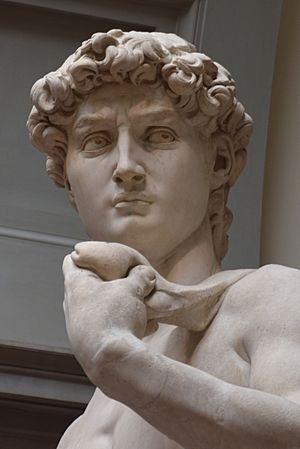David (Michelangelo) facts for kids
The David is a famous statue created by the artist Michelangelo. He worked on it from 1501 to 1504. This huge statue is made of marble and stands 17 feet (5.17 meters) tall. It shows David, a young shepherd from the Bible. The story tells how David bravely fought a giant soldier named Goliath. David won by using a small stone from his slingshot. He later became the King of Israel.
Michelangelo sculpted David without clothes, similar to how ancient Roman statues of heroes were often made. The statue shows David just before his fight. He is looking at Goliath, thinking about his plan.
The people who paid for the statue were wool-workers in Florence, Italy. For the city of Florence, David was a powerful symbol. He represented how a small, strong city could fight against bigger invaders. David was also special to the wool-workers because he was a shepherd who cared for sheep. As a king, he was like a shepherd guiding his people.
The David statue is a symbol of Florence, Italy. It is Michelangelo's most famous sculpture. People often simply call it The David.
Contents
Making the Famous David Statue
Around 1464, members of the Wool Guild in Florence wanted to create twelve statues. These statues were of important people from the Old Testament of the Bible. They planned to place them high up on the outside walls of the Florence Cathedral.
Two statues had already been started by other artists. One artist, Agostino di Duccio, began carving a statue of David. He worked on the feet and chest. But he stopped in 1466 when his teacher, Donatello, died. Another artist, Antonio Rossellino, worked on it for two more years.
The large block of marble then sat untouched for 33 years. It was left in the cathedral workshop and started to get damaged by the weather. Michelangelo began working on this same block of stone on September 13, 1501. He finished the incredible statue on September 8, 1504.
Where David Was Placed
When the David statue was finished, it was placed in front of the Palazzo Vecchio. This was an important government building in Florence. In 1873, the statue was moved indoors to the Accademia Gallery in Florence. This was done to protect it from weather and damage. Today, many visitors come to the Accademia Gallery just to see the David statue.
Damage to the Statue
In 1991, an artist named Piero Cannata attacked the statue. He used a hammer that he had hidden. He damaged the second toe on David's left foot. Museum visitors stopped him until the police arrived. Small pieces of the statue fell to the floor. Guards caught three tourists trying to leave with these pieces.
Copies of the Statue
Michelangelo's David has been on display at Florence's Galleria dell'Accademia since 1873. Many copies of the statue have been made.
In 1846, Grand Duke Leopold II asked an artist named Clemente Papi to make a plaster cast of the David. Papi was skilled at making molds and copies. He made two plaster copies from his molds. In 1857, Leopold II gave one of these copies to Queen Victoria of England.
Papi also made a full-size bronze copy of the statue. This copy was placed in the Piazzale Michelangelo in Florence in 1875. This was to celebrate 400 years since Michelangelo's birth.
The copy sent to Queen Victoria was a gift to improve relations between their countries. Queen Victoria was surprised by the gift. She gave the statue to the new South Kensington Museum, which is now the Victoria and Albert Museum. The copy that stayed in Florence has been used to make all other copies of the David.
Michelangelo's statue is one of the most famous artworks from Florence. It is also one of the most copied.
Other pages
The following are other statues by Michelangelo:
Images for kids
See also
 In Spanish: David (Miguel Ángel) para niños
In Spanish: David (Miguel Ángel) para niños




